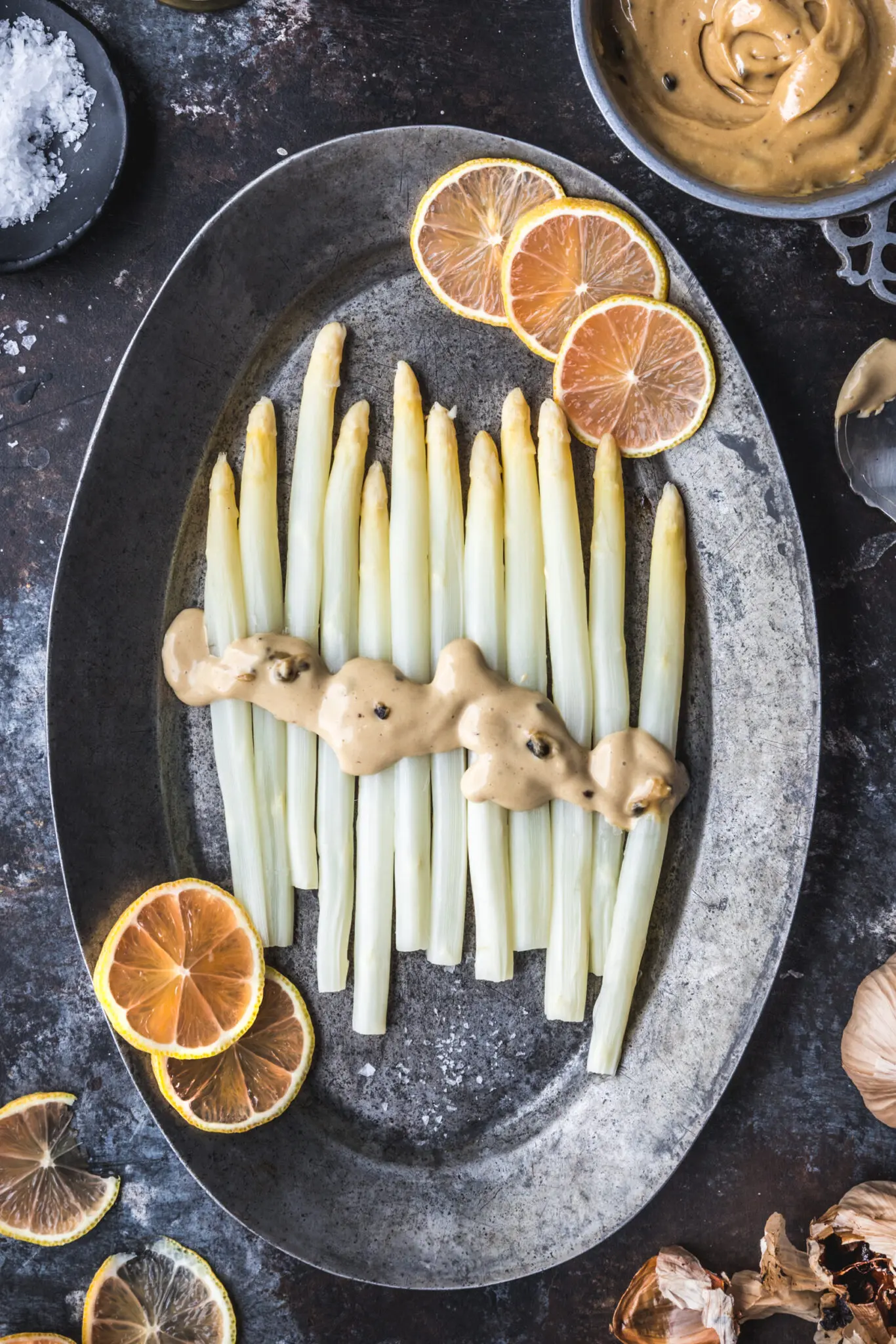
If fresh, local asparagus is in the stores, it must be early Spring. This vegetable is one of the first to beckon in the new season and herald an end to Winter. We simmer the delicate white asparagus spears until they become tender and sweet, then drizzle them with a homemade aioli flavored with black garlic, lemon, and miso. It’s both simple and incredibly delicious.
Note: This recipe will work just as well with green asparagus, if that’s what you have (and the Black Garlic Aioli is delicious on just about anything. It’s crazy good).
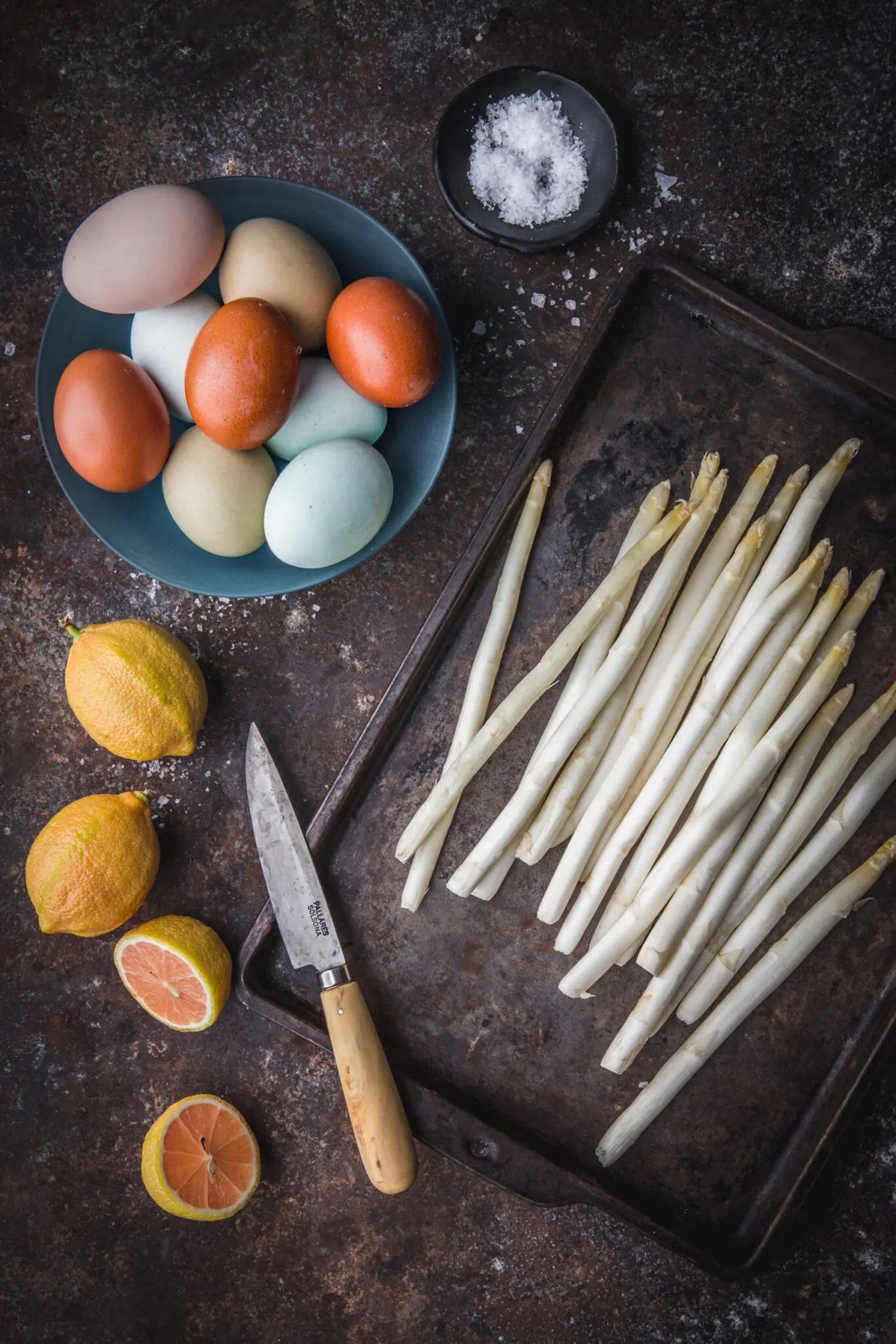
What is white asparagus?
If you’ve never had white asparagus, it’s worth seeking out. These spears have either been grown entirely underground or in an environment without sunlight — the trigger that normally would activate chlorophyll in the vegetable and turn it green. White asparagus has a delicate appearance and a milder flavor than its more common green variety.
Asparagus in the vegetable garden
This recipe was also inspired by the fact that, for the first time, we’re growing asparagus in our vegetable garden. Generally, when you do this, gardeners will recommend that you buy established asparagus crowns, which will provide spears the same year. Growing asparagus from seeds is an exercise in patience and goes something like this:
Year 1: You may eat one (1) asparagus spear, as a treat.
Year 2: Don’t look at the asparagus! Don’t even think about it too hard! It’s still recovering from when you ate that one (1) spear last year.
Year 3: You may now eat several (3 – 4) asparagus spears, assuming you’re not still full after you gorged yourself on that one (1) spear two years ago, you absolute ape.
So, you know, it’s not exactly an immediate-gratification endeavor. But we decided to take the long haul — mostly because we couldn’t get our hands on asparagus crowns — and there are now a handful of seedlings developing merrily under lights until it’s time to harden them off and get them out in the beds.
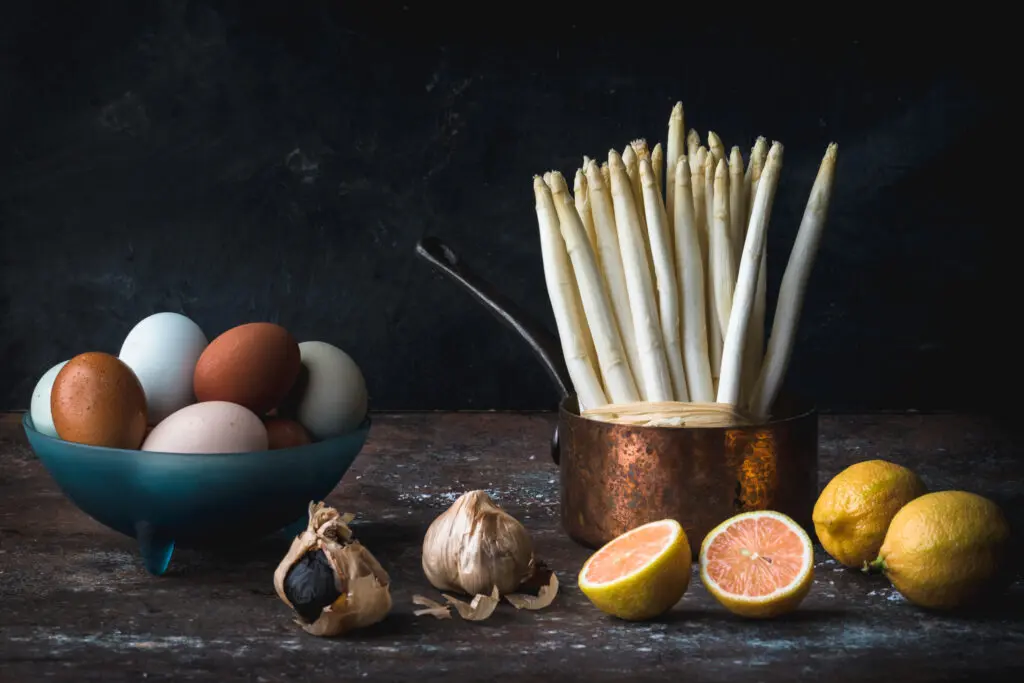
Black Garlic
We’ve been intrigued by black garlic ever since a garlic farm at our local farmer’s market started selling it. Black garlic is a bulb of garlic that has been cooked with very low, very gentle heat for a long time, producing soft-as-paste, sweet, nutty and very dark cloves. The flavor is more similar to roasted garlic than fresh, so you can use quite a bit without it becoming overpowering.
Unfortunately, it’s been so popular that the stall sells out within an hour of opening, so we decided to try making our own. Like asparagus growing, making black garlic is another process that requires patience. It’s not quite three years this time, but definitely several weeks of very careful heating in a dehydrator or controlled environment. We tried using a slow cooker, but even that was a little too hot for the process: we ended up with hard, brown garlic cloves. We ground them into a delicious toasted garlic powder, but it wasn’t at all what we were after. So until we’ve perfected our process, we’re using store-bought versions.
You might be able to find black garlic at a local specialty food store, farmer’s market, or if you have a local garlic farm, it’s worth asking them. If you want to tackle it yourself, and you have a proofer/controllable slow cooker like the Brod and Taylor folding proofer, Brad Leone at Bon Appetit has a good explanation of the process.
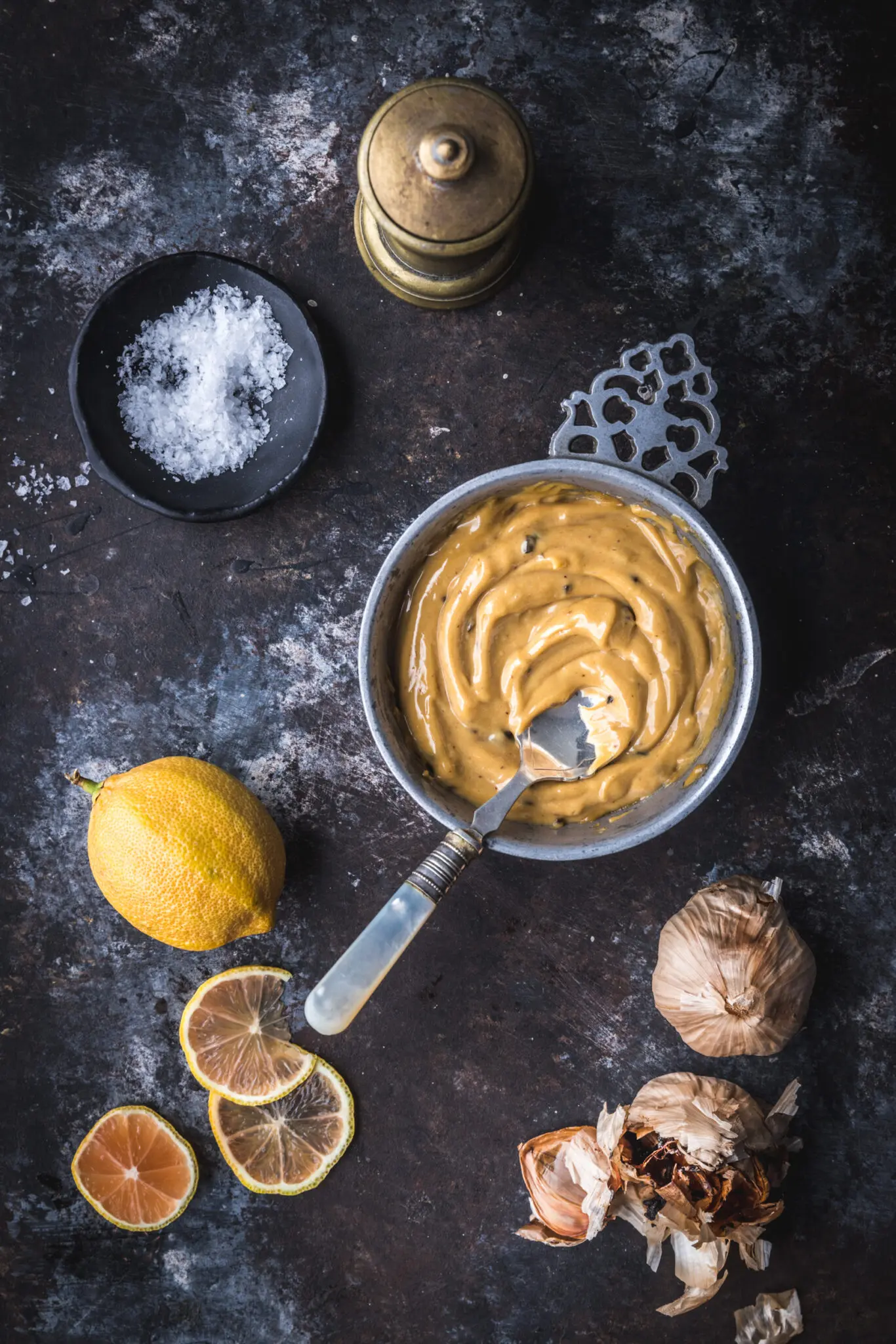
Black Garlic Aioli
Making aioli (garlicky mayonnaise) at home is way easier than most people realize, and well worth the effort. All you’re doing really is whisking a slow drizzle of oil into egg yolks to create a thick emulsion. For this recipe, we wanted to use a small amount of regular fresh garlic for that familiar kick, but enhance it with the more complex flavors of black garlic, and just a touch of white miso. A little lemon juice brightens it up, and adds that perfect zing.
Full confession: Our aioli initially broke, remaining thin and not emulsified. Here’s why: We started out by using our Vitamix blender. It’s great for larger amounts of liquid, but because the blades are slightly lifted off of the base of the jug, it doesn’t effectively mix smaller quantities. So even though we were adding the oil in a slow drizzle, it wasn’t getting fully mixed into the yolks.
To remedy it, we took the hand-mixed route, which is what we recommend you do as well. We poured the entire liquid back from the blender into a measuring jug. We added one more egg yolk to a large metal mixing bowl, and whisked it by hand while drizzling the broken aioli slowly onto it. This gave us much better control and allowed the emulsion to form very easily. Because we’d added another yolk, we also felt comfortable adding a little more extra oil and lemon juice to balance out the richness.
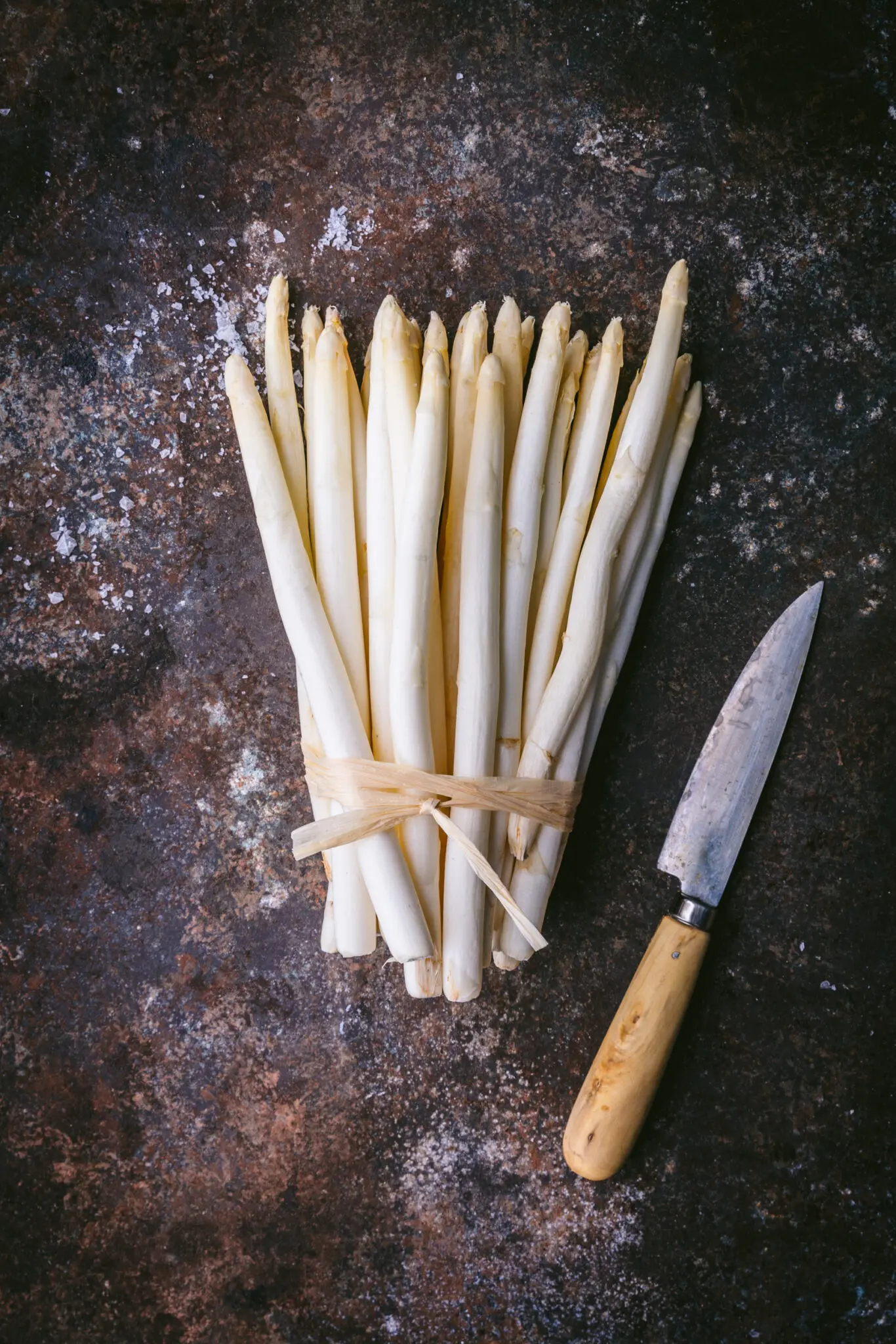
Tips for buying, storing and prepping white asparagus
Look for firm, plump stems. The cut at the bottom should not be dried out and wrinkly. The skin should be pale, silky white – though the tips can sometimes be pale yellow or lavender. The tip should be firm and lightly compacted.
You can store raw asparagus in the refrigerator for a few days. Wrap it loosely in a slightly moist paper towel and place it in an unsealed plastic bag. Keep the bag open to ensure air circulation.
White asparagus is delicate and brittle so be a little careful as you prep it. Unlike most green asparagus (except for those with especially thick stems), white asparagus has a tough, fibrous outer layer that has to be peeled away. Lay the stalks flat on a work surface and cut about 1 to 2 inches off the bottom end. Keeping the stems flat against the work surface, use a sharp vegetable peeler to peel all the way from just below the tip, down to the bottom.
Once peeled, gather the asparagus in manageable bundles (about 10 to 12 stems) and tie them together with butcher string. This keeps the stalks stable and will keep them from breaking as they cook. You can use the string to lower the bundles into and out of the simmering water.
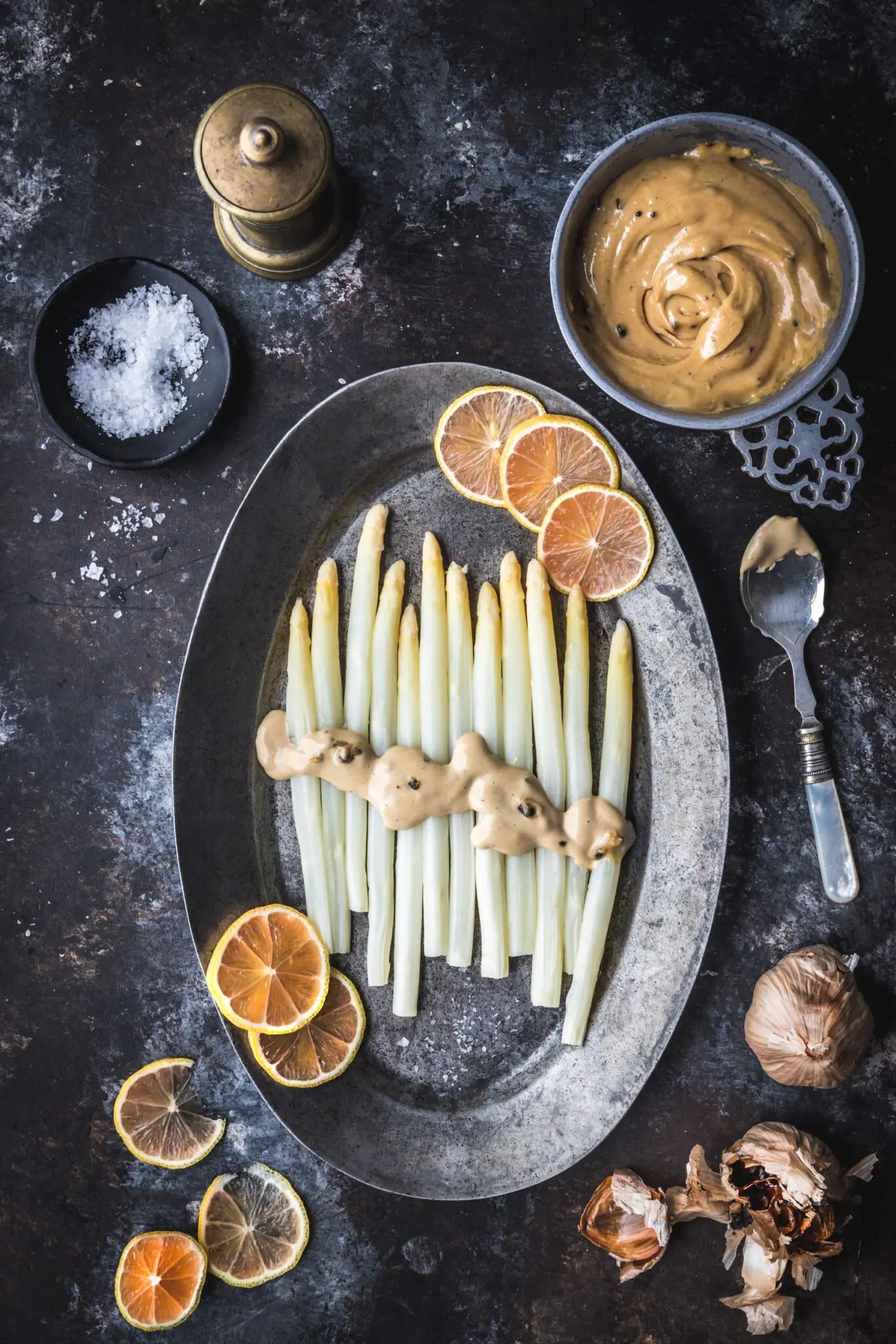
White Asparagus with Black Garlic Aioli
Ingredients
For the asparagus
- 1 -2 pounds white asparagus
- 2 tablespoons kosher salt
- 1 lemon halved
For the Black Garlic Aioli:
- 1 teaspoon grated fresh garlic (about 1 small clove)
- 1 tablespoon black garlic crushed into a paste (about 3 medium cloves)
- 1 tablespoon lemon juice plus more as needed
- 1/2 teaspoon kosher salt
- 2 egg yolks large
- 2 teaspoons white miso
- 1 cup neutral oil like grapeseed
Instructions
Cook the asparagus:
- Bring 4 quarts of water to a simmer in a large pot set over medium heat. Add the salt and squeeze in the juice from both lemon halves and add the rinds into the pot.
- Meanwhile, lay the spears on a work surface and trim about a half inch off the bottom ends. Use a sharp vegetable peeler to peel the skin from each spear, starting 1 1/2-inches from the tip, and running the length of the spear. (Be gentle, the spears are brittle and can snap easily).
- Gather spears into 2 or 3 bundles and tie them loosely with kitchen string (this keeps them more stable as they cook). Simmer, increasing the heat as needed to maintain a low simmer, until fully tender when pierced with a knife, 8 to 30 minutes, depending on thickness of asparagus. Gently remove the bundles and drain on paper towels. Keep them covered with covered with a moist towel until ready to serve.
Make the Black Garlic Aioli:
- Place a medium bowl on a non-skid pad or damp kitchen towel. Add the fresh garlic, black garlic, lemon juice, salt, egg yolks and miso to the bowl and whisk until roughly combined. While whisking constantly, very slowly begin adding the oil, a few drops at a time until an emulsion forms and the mixture thickens. Once about half of the oil has been incorporated and the mixture is quite thick, you can begin to add the oil a little faster, in a slow drizzle until the aioli is thick and creamy. Taste and adjust the seasoning with salt and lemon juice. If the aioli is too thick, stir in water, a scant teaspoon at a time, until the correct consistency is achieved.
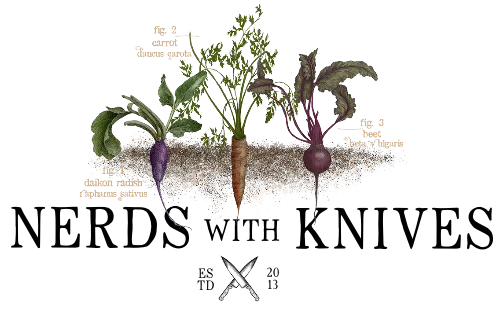

If you have a dehydrator you should give it a go for your black garlic – mine works a treat!
Also, have you tried making your mayo using an immersion blender? Under two minutes from start to finish – and I’ve never had it break
Looking forward to trying this; I adore all the things
I’ve heard dehydrators are great for black garlic! We don’t have one (yet) but will hopefully get one soon. And yes, thanks for reminding me that the immersion blender method is AMAZING for mayo. I did it a couple of times with great success, but I broke the tall narrow vessel you need for it to work. Thanks for reminding me to get another one!